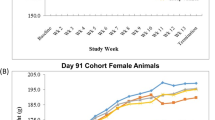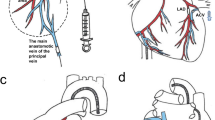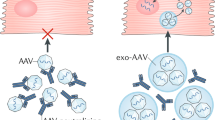Abstract
Gene therapy is a promising new treatment option for cardiac diseases. For finding the most suitable and safe vector for cardiac gene transfer, we delivered adenovirus (AdV), adeno-associated virus (AAV) and lentivirus (LeV) vectors into the mouse heart with sophisticated closed-chest echocardiography-guided intramyocardial injection method for comparing them with regards to transduction efficiency, myocardial damage, effects on the left ventricular function and electrocardiography (ECG). AdV had the highest transduction efficiency in cardiomyocytes followed by AAV2 and AAV9, and the lowest efficiency was seen with LeV. The local myocardial inflammation and fibrosis in the left ventricle (LV) was proportional to transduction efficiency. AdV caused LV dilatation and systolic dysfunction. Neither of the locally injected AAV serotypes impaired the LV systolic function, but AAV9 caused diastolic dysfunction to some extent. LeV did not affect the cardiac function. We also studied systemic delivery of AAV9, which led to transduction of cardiomyocytes throughout the myocardium. However, also diffuse fibrosis was present leading to significantly impaired LV systolic and diastolic function and pathological ECG changes. Compared with widely used AdV vector, AAV2, AAV9 and LeV were less effective in transducing cardiomyocytes but also less harmful. Local administration of AAV9 was safer and more efficient compared with systemic administration.
This is a preview of subscription content, access via your institution
Access options
Subscribe to this journal
Receive 12 print issues and online access
$259.00 per year
only $21.58 per issue
Buy this article
- Purchase on Springer Link
- Instant access to full article PDF
Prices may be subject to local taxes which are calculated during checkout





Similar content being viewed by others
References
Lozano R, Naghavi M, Foreman K, Lim S, Shibuya K, Aboyans V et al. Global and regional mortality from 235 causes of death for 20 age groups in 1990 and 2010: a systematic analysis for the Global Burden of Disease Study 2010. Lancet 2012; 380: 2095–2128.
Dragneva G, Korpisalo P, Yla-Herttuala S . Promoting blood vessel growth in ischemic diseases: challenges in translating preclinical potential into clinical success. Dis Model Mech 2013; 6: 312–322.
Halonen PJ, Nurro J, Kuivanen A, Yla-Herttuala S . Current gene therapy trials for vascular diseases. Expert Opin Biol Ther 2014; 14: 327–336.
Lahteenvuo JE, Lahteenvuo MT, Kivela A, Rosenlew C, Falkevall A, Klar J et al. Vascular endothelial growth factor-B induces myocardium-specific angiogenesis and arteriogenesis via vascular endothelial growth factor receptor-1- and neuropilin receptor-1-dependent mechanisms. Circulation 2009; 119: 845–856.
Rutanen J, Rissanen TT, Markkanen JE, Gruchala M, Silvennoinen P, Kivela A et al. Adenoviral catheter-mediated intramyocardial gene transfer using the mature form of vascular endothelial growth factor-D induces transmural angiogenesis in porcine heart. Circulation 2004; 109: 1029–1035.
Yla-Herttuala S . Cardiovascular gene therapy with vascular endothelial growth factors. Gene 2013; 525: 217–219.
Hedman M, Muona K, Hedman A, Kivela A, Syvanne M, Eranen J et al. Eight-year safety follow-up of coronary artery disease patients after local intracoronary VEGF gene transfer. Gene Therapy 2009; 16: 629–634.
Muona K, Makinen K, Hedman M, Manninen H, Yla-Herttuala S . 10-year safety follow-up in patients with local VEGF gene transfer to ischemic lower limb. Gene Therapy 2012; 19: 392–395.
Hedman M, Hartikainen J, Yla-Herttuala S . Progress and prospects: hurdles to cardiovascular gene therapy clinical trials. Gene Therapy 2011; 18: 743–749.
Huusko J, Merentie M, Dijkstra MH, Ryhanen MM, Karvinen H, Rissanen TT et al. The effects of VEGF-R1 and VEGF-R2 ligands on angiogenic responses and left ventricular function in mice. Cardiovasc Res 2010; 86: 122–130.
Rissanen TT, Yla-Herttuala S . Current status of cardiovascular gene therapy. Mol Ther 2007; 15: 1233–1247.
Zaiss AK, Liu Q, Bowen GP, Wong NC, Bartlett JS, Muruve DA . Differential activation of innate immune responses by adenovirus and adeno-associated virus vectors. J Virol 2002; 76: 4580–4590.
Gruchala M, Roy H, Bhardwaj S, Yla-Herttuala S . Gene therapy for cardiovascular diseases. Curr Pharm Des 2004; 10: 407–423.
Wasala NB, Shin JH, Duan D . The evolution of heart gene delivery vectors. J Gene Med 2011; 13: 557–565.
Zacchigna S, Zentilin L, Giacca M . Adeno-associated virus vectors as therapeutic and investigational tools in the cardiovascular system. Circ Res 2014; 114: 1827–1846.
Zincarelli C, Soltys S, Rengo G, Rabinowitz JE . Analysis of AAV serotypes 1-9 mediated gene expression and tropism in mice after systemic injection. Mol Ther 2008; 16: 1073–1080.
Prasad KM, Smith RS, Xu Y, French BA . A single direct injection into the left ventricular wall of an adeno-associated virus 9 (AAV9) vector expressing extracellular superoxide dismutase from the cardiac troponin-T promoter protects mice against myocardial infarction. J Gene Med 2011; 13: 333–341.
Li Q, Xie J, Li R, Shi J, Sun J, Gu R et al. Overexpression of microRNA-99a attenuates heart remodelling and improves cardiac performance after myocardial infarction. J Cell Mol Med 2014; 18: 919–928.
Zhao J, Pettigrew GJ, Thomas J, Vandenberg JI, Delriviere L, Bolton EM et al. Lentiviral vectors for delivery of genes into neonatal and adult ventricular cardiac myocytes in vitro and in vivo. Basic Res Cardiol 2002; 97: 348–358.
Fleury S, Simeoni E, Zuppinger C, Deglon N, von Segesser LK, Kappenberger L et al. Multiply attenuated, self-inactivating lentiviral vectors efficiently deliver and express genes for extended periods of time in adult rat cardiomyocytes in vivo. Circulation 2003; 107: 2375–2382.
Niwano K, Arai M, Koitabashi N, Watanabe A, Ikeda Y, Miyoshi H et al. Lentiviral vector-mediated SERCA2 gene transfer protects against heart failure and left ventricular remodeling after myocardial infarction in rats. Mol Ther 2008; 16: 1026–1032.
Turunen MP, Husso T, Musthafa H, Laidinen S, Dragneva G, Laham-Karam N et al. Epigenetic upregulation of endogenous VEGF-A reduces myocardial infarct size in mice. PLoS One 2014; 9: e89979.
Terman A, Brunk UT . The aging myocardium: roles of mitochondrial damage and lysosomal degradation. Heart Lung Circ 2005; 14: 107–114.
Katz MG, Fargnoli AS, Williams RD, Bridges CR . Gene therapy delivery systems for enhancing viral and nonviral vectors for cardiac diseases: current concepts and future applications. Hum Gene Ther 2013; 24: 914–927.
Toivonen R, Koskenvuo J, Merentie M, Soderstrom M, Yla-Herttuala S, Savontaus M . Intracardiac injection of a capsid-modified Ad5/35 results in decreased heart toxicity when compared to standard Ad5. Virol J 2012; 9: 296–422X-9-296.
Vassalli G, Bueler H, Dudler J, von Segesser LK, Kappenberger L . Adeno-associated virus (AAV) vectors achieve prolonged transgene expression in mouse myocardium and arteries in vivo: a comparative study with adenovirus vectors. Int J Cardiol 2003; 90: 229–238.
Inagaki K, Fuess S, Storm TA, Gibson GA, Mctiernan CF, Kay MA et al. Robust systemic transduction with AAV9 vectors in mice: efficient global cardiac gene transfer superior to that of AAV8. Mol Ther 2006; 14: 45–53.
Bostick B, Ghosh A, Yue Y, Long C, Duan D . Systemic AAV-9 transduction in mice is influenced by animal age but not by the route of administration. Gene Therapy 2007; 14: 1605–1609.
Rincon MY, VandenDriessche T, Chuah MK . Gene therapy for cardiovascular disease: advances in vector development, targeting, and delivery for clinical translation. Cardiovasc Res 2015; 108: 4–20.
Wirth T, Hedman M, Makinen K, Manninen H, Immonen A, Vapalahti M et al. Safety profile of plasmid/liposomes and virus vectors in clinical gene therapy. Curr Drug Saf 2006; 1: 253–257.
Yla-Herttuala S, Rissanen TT, Vajanto I, Hartikainen J . Vascular endothelial growth factors: biology and current status of clinical applications in cardiovascular medicine. J Am Coll Cardiol 2007; 49: 1015–1026.
Hareendran S, Balakrishnan B, Sen D, Kumar S, Srivastava A, Jayandharan GR . Adeno-associated virus (AAV) vectors in gene therapy: immune challenges and strategies to circumvent them. Rev Med Virol 2013; 23: 399–413.
Basner-Tschakarjan E, Bijjiga E, Martino AT . Pre-clinical assessment of immune responses to adeno-associated virus (AAV) vectors. Front Immunol 2014; 5: 28.
Meloni M, Descamps B, Caporali A, Zentilin L, Floris I, Giacca M et al. Nerve growth factor gene therapy using adeno-associated viral vectors prevents cardiomyopathy in type 1 diabetic mice. Diabetes 2012; 61: 229–240.
Bish LT, Morine K, Sleeper MM, Sanmiguel J, Wu D, Gao G et al. Adeno-associated virus (AAV) serotype 9 provides global cardiac gene transfer superior to AAV1, AAV6, AAV7, and AAV8 in the mouse and rat. Hum Gene Ther 2008; 19: 1359–1368.
Gregorevic P, Blankinship MJ, Allen JM, Crawford RW, Meuse L, Miller DG et al. Systemic delivery of genes to striated muscles using adeno-associated viral vectors. Nat Med 2004; 10: 828–834.
Hazen MS, Marwick TH, Underwood DA . Diagnostic accuracy of the resting electrocardiogram in detection and estimation of left atrial enlargement: an echocardiographic correlation in 551 patients. Am Heart J 1991; 122: 823–828.
Li Q, Guo Y, Tan W, Stein AB, Dawn B, Wu WJ et al. Gene therapy with iNOS provides long-term protection against myocardial infarction without adverse functional consequences. Am J Physiol Heart Circ Physiol 2006; 290: H584–H589.
Zolotukhin S, Byrne BJ, Mason E, Zolotukhin I, Potter M, Chesnut K et al. Recombinant adeno-associated virus purification using novel methods improves infectious titer and yield. Gene Therapy 1999; 6: 973–985.
Huusko J, Lottonen L, Merentie M, Gurzeler E, Anisimov A, Miyanohara A et al. AAV9-mediated VEGF-B gene transfer improves systolic function in progressive left ventricular hypertrophy. Mol Ther 2012; 20: 2212–2221.
Makinen PI, Koponen JK, Karkkainen AM, Malm TM, Pulkkinen KH, Koistinaho J et al. Stable RNA interference: comparison of U6 and H1 promoters in endothelial cells and in mouse brain. J Gene Med 2006; 8: 433–441.
Merentie M, Lipponen JA, Hedman M, Hedman A, Hartikainen J, Huusko J et al. Mouse ECG findings in aging, with conduction system affecting drugs and in cardiac pathologies: Development and validation of ECG analysis algorithm in mice. Physiol Rep 2015; 3 pii e12639.
Liu G, Iden JB, Kovithavongs K, Gulamhusein R, Duff HJ, Kavanagh KM . In vivo temporal and spatial distribution of depolarization and repolarization and the illusive murine T wave. J Physiol 2004; 555: 267–279.
Acknowledgements
This work was supported by grants from Finnish Academy, ERC, Finnish Foundation for Cardiovascular Diseases, Sigrid Juselius Foundation and Kuopio University Hospital, Summit (Grant Agreement number 115006, IMI). We thank Sari Järveläinen, Tiina Koponen, Tuula Salonen, Anne Martikainen and Seija Sahrio for technical assistance and the staff at The National Laboratory Animal Center of the University of Eastern Finland (Kuopio campus) for maintenance of the animals. pDG helper plasmid was a kind gift from Dr Jürgen A Kleinschmidt, (German Cancer Research Center, Heidelberg, Germany).
Author information
Authors and Affiliations
Corresponding author
Ethics declarations
Competing interests
The authors declare no conflict of interest.
Rights and permissions
About this article
Cite this article
Merentie, M., Lottonen-Raikaslehto, L., Parviainen, V. et al. Efficacy and safety of myocardial gene transfer of adenovirus, adeno-associated virus and lentivirus vectors in the mouse heart. Gene Ther 23, 296–305 (2016). https://doi.org/10.1038/gt.2015.114
Received:
Revised:
Accepted:
Published:
Issue Date:
DOI: https://doi.org/10.1038/gt.2015.114
This article is cited by
-
OSMR deficiency aggravates pressure overload-induced cardiac hypertrophy by modulating macrophages and OSM/LIFR/STAT3 signalling
Journal of Translational Medicine (2023)
-
p38γ/δ activation alters cardiac electrical activity and predisposes to ventricular arrhythmia
Nature Cardiovascular Research (2023)
-
Cationic microRNA-delivering nanocarriers for efficient treatment of colon carcinoma in xenograft model
Gene Therapy (2016)



